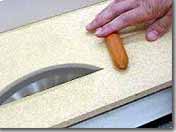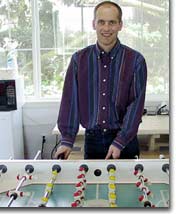Steve Gass
Steve Gass has a Ph.D. in physics and a dangerous hobby. An amateur woodworker, Gass cuts wood with table saws that spin almost 70 times a second. The saws' sharp, quickly spinning blades can chop off a finger; in fact, over 3,000 people a year lose fingers to table saws. One day in his workshop, Gass looked at his saw and wondered how quickly he could stop the blade in the event of accidental contact. “From a physics standpoint, it was really a very interesting project,” he said. He realized that to make the saw blade stop quickly enough to avoid a serious injury, he would have to stop the blade in 1/100th of a of a second or less. He thought that stopping the blade that quickly would be possible, and he used his physics training to find a way to do it.

Steve Gass using a hot dog to demonstrate SawStop.
Watch videos of SawStop in action.

Steve Gass playing foos ball. Can he stop a foos ball with a quarter turn?
His experiments led to SawStop, a simple system that can be incorporated into table saws or other types of woodworking equipment. When the blade touches a finger, the system recognizes the difference in electrical capacitance between wood and flesh and stops a spinning blade within a quarter turn. Gass built a prototype of the SawStop in his workshop and tested it by placing a hot dog on a board to simulate a human finger. The saw cut through the board easily, but when the blade touched the hot dog, it stopped cold.
The capacitance of a hot dog is similar to the capacitance of a finger, but not exactly the same. Gass knew that to prove SawStop worked, he would have to test his machine on his finger. “I can tell you that to touch a spinning saw blade goes against every instinct that you would have,” he said. “When I was trying to reach my finger out to gently touch the edge of the blade, the muscles in my forearm were just spasming wanting to pull my fingers back. It was so hard.” The blade stopped, leaving Gass with only a small, 1/32 inch deep cut on his finger. He put a Band-Aid on the cut and took his SawStop to the world.
Gass exhibited SawStop at the International Woodworking Fair in Atlanta, Georgia in August 2000, and his invention won the Challengers Distinguished Achievement Award as one of the most innovative new products in woodworking. Since then, he has founded a company called SawStop to sell his invention, and all of the major woodworking equipment manufacturers have approached Gass about adding SawStops to the saws they make. “We hope that it will be on every saw sold in a few years,” he said.
Gass grew up on a horse ranch in the countryside of eastern Oregon. He began woodworking at age 4 and never stopped. “I just love to build things,” he said. He was also always interested in how things worked, and this interest led him to study physics. He went to college at Oregon State University, and got a Ph.D. in physics from the University of California at San Diego, studying how proteins fold. As his graduation neared, he realized that he did not want a career in academic research, where he would have to spend much of his time writing grants. “I loved the science, but it didn't seem like a very good lifestyle. So I thought, 'well, what else can I do with my degree in physics?',” he said. He went to law school at the University of California at Berkeley, then became a patent attorney.
As a patent attorney, Gass worked with inventors and companies to --patent their inventions and prevent them from being copied. He worked with inventors of everything from toys to semiconductor devices. “One of the things I enjoyed about the practice was the breadth of technology I got to be exposed to,” he said. Of the inventions he helped to patent, his favorite was a screw that doctors used to hold broken bones together. While working as an attorney, Gass continued his woodworking projects, building a 4,000 square foot workshop behind his house. “When I was a little kid, I liked playing with Legos,” he said. “I just never quit.”











